- solen.cz - Cervicogenic syndromes. MUDr. Miloslav Dvorák
- theses.cz - Physiotherapy in patients with sedentary occupation suffering from recurrent pain in the cervical spine. Author.
- pubmed.ncbi.nlm.nih.gov - Advances in the diagnosis and management of neck pain. Steven P Cohen, W Michael Hooten
What causes pain in the muscles of the cervical spine? + 5 relaxation exercises to do at home
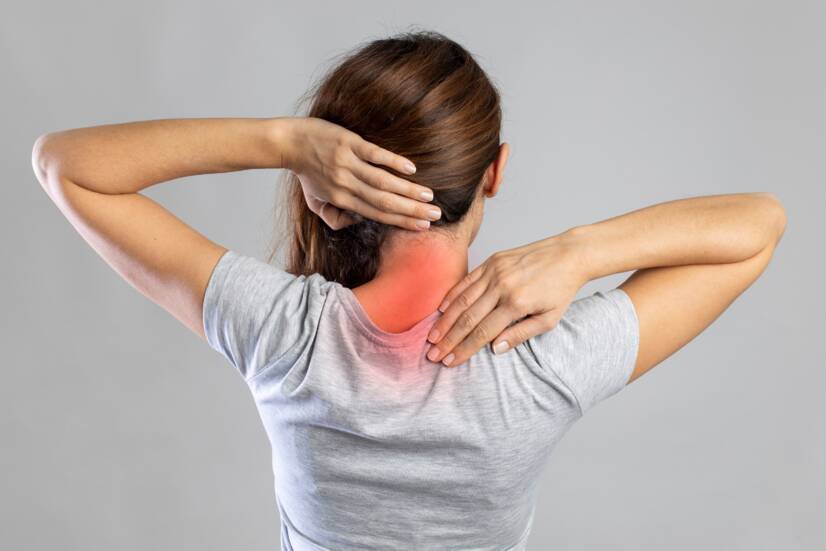
Cervical spine pain is a common problem, especially for people with sedentary jobs. What are some good relaxation exercises you can do at home to prevent cervical spine pain?
Article content
Cervical spine
The cervical spine begins at the skull and ends at the transition to the thoracic spine. It is made up of 7 vertebrae, called C1-C7 (vertebrae cervicales).
The cervical spine is where the extensor muscles of the head, back, chest and shoulders are located.
Due to the large number of muscles in the cervical spine, muscular imbalances - a disproportion of overstretched/shortened and weakened muscles - easily occur. This leads to pain.
Diagnosing the source of pain
Identifying the cause of the pain is the basis of proper treatment. For prolonged pain or pain with an unclear cause, it is essential to see a doctor.
It is necessary to exclude mechanical damage, displacement of the intervertebral disc, a neurological cause, degenerative damage, an inflammatory process or other organic structural disorder.
If the pain shoots into the thoracic region or upper limbs, a visit to a doctor is advisable. Shooting, burning or tingling pain may indicate a nerve problem.
Diagnosis is made during an examination by a medical professional who will assess the patient's condition.
The doctor will then recommend rehabilitation therapy or further diagnostic physical examination (X-ray, MRI) to accurately detect/exclude a structural problem.
Most often, this is muscle pain caused by muscle imbalance - an imbalance of overstretched and weakened muscles.
Muscle pain is characterized by a dull ache over the muscle fibers. The usual sensation is stiffness, heaviness and the presence of painful irritation points in the muscle - palpable stiff balls over the muscle.
These signal overload of the muscle fibre in question.
Muscle pain in the cervical spine
Muscle imbalances are often caused by incorrect posture and inappropriate stereotypical movement patterns. In the upper body, this can be a common musculoskeletal phenomenon - upper crossed syndrome.
There is overloading of the trapezius muscles with possible shortening of the pectoral muscles. The anterior cervical and interscapular muscles are weakened and flaccid.
Shortening and overloading of the posterior cervical muscles - the trapezius and scapular extensor muscles - is the most common phenomenon in people with poor posture and head posture. A common condition is flaccidity and weakening of the anterior cervical muscle group.
Common causes of cervical spine muscle pain:
- Improper posture and head posture
- Sedentary occupation
- Non-physiological sitting
- Manual unilateral employment
- Weakened musculoskeletal system
- Excessive load on muscles
- Incorrect exercise technique
- Incorrect rapid movement
- Lack of compensatory activity
Problem trapezius muscle
The musculus trapezius (trapezius muscle) is a powerful muscle. It starts in the cranial part, extends through the cervical spine and shoulder blades, and attaches to the shoulders and base of the thoracic spine. Its main function is to flex and bend the head.
With incorrect head posture (called SMS neck), the trapezius muscle is chronically overworked and shortened along with the scapular elevator (musculus levator scapulae).
Reflexively, the muscle tension of the muscles on the front of the neck, whose function is to bend the head, is reduced.
Non-physiological muscle tension and the state of the trapezius attachment in the gluteal region can cause headache, migraine or nausea.
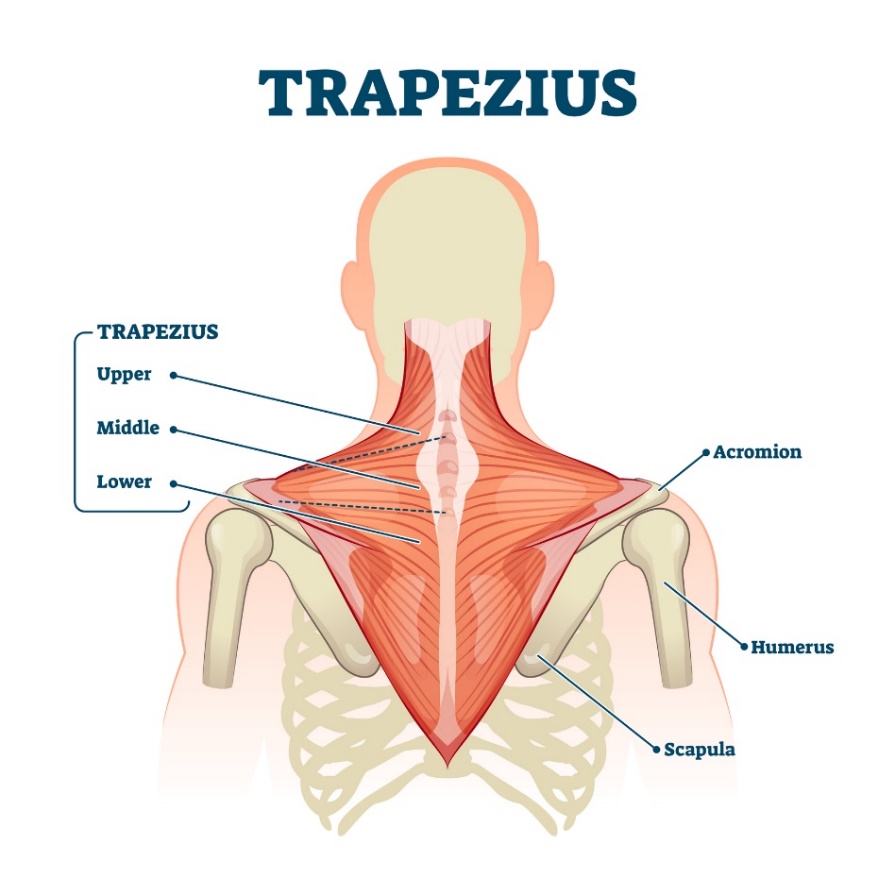
Relaxation exercises for the cervical spine at home
The following exercises are for people without spinal surgery or other organic disorders. For exercises after surgery/injury or if unclear, consult a specialist first.
Relaxing the neck into a bow
Sit in a chair with your back straight and your head in extension. The hip joints are at right angles to the torso. The shoulders are loosely lowered away from the ears and the upper limbs hang towards the ground. Place the palm of your right hand on the left ear and the left side of your head.
With a deep exhalation, bring the head to the right shoulder with the right hand in a bow. Breathe smoothly and stretch the left trapezius muscle for at least 15 seconds. Be careful not to raise the shoulders to the ears.
Then switch hands and stretch the right trapezius.
Repeat the exercise at least 3-5 times on each side.
Relax the neck into a forward bend
The starting position for this exercise is the same as for the previous exercise. Sit upright in a natural sitting position with the arms lowered away from the ears. The hip joints are at right angles to the torso. Interlace the palms of the hands and place them on the back of the neck.
Exhaling, bring the head to the front of the body and mentally dig the chin into the collarbone. Breathe smoothly and stretch the upper, middle and lower trapezius fibres for at least 15 seconds.
Repeat 3-5 times.
You should feel a slight pull on the back muscle group.
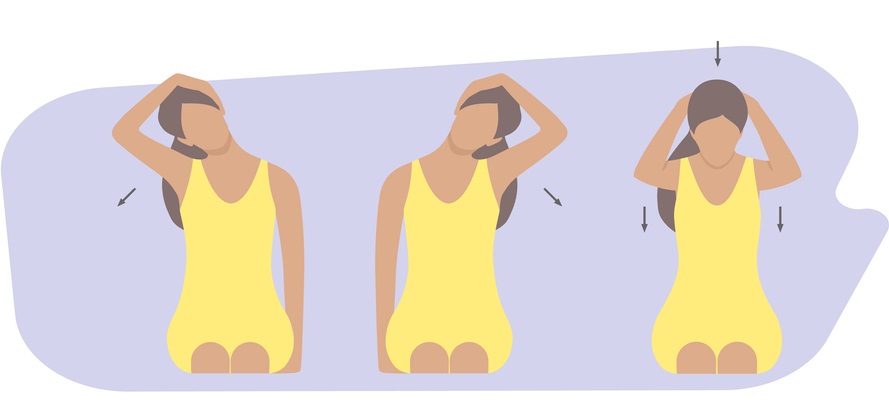
Neck semicircles in supine position
Sit in a chair, shoulders lowered loosely away from the ears and arms hanging towards the ground. Breathing is slow and smooth. Turn your head to the left as far as your head will allow. Gently lean forward and bury your head in the hollow of your collarbone.
Slowly, while bending over, move your chin in an imaginary semicircle along the collarbone to the right side.
Make at least 3 semicircles to each side.
The exercise stretches and relaxes the trapezius and scapular extensor muscles. You should feel a slight pull in the back muscles.

Neck and chin tuck
The basic position is sitting upright in a chair in a comfortable position with the shoulders and arms loosely hanging down from the ears. The hip joints make a right angle with the torso. Place the index finger of your hand on the front of the chin. Push the chin in - backwards.
Make as large a "double chin" as possible and activate the muscles of the front of the neck. With proper technique, you should feel the front group strengthen and the back group of neck muscles stretch at the same time.
Stay in the "tucked" position for at least 10 seconds and finally release.
Repeat 15 times.
Breathe freely during the exercise.
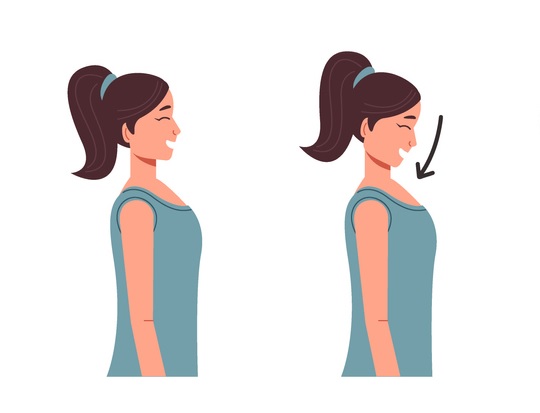
Shoulder and chest muscle relaxation
Sitting upright in a chair, the hip joints and torso are at right angles. The head is in extension of the spine and the shoulders are lowered away from the ears. Raise the right arm and move it behind the head from above. From below, move the left arm to the back.
Interlace the fingers of the hands or try to touch the fingers of the hands behind the back. Breathe smoothly and stay in the position for at least 15 seconds. Then switch hands.
Repeat the exercise 3-5 times on each side.
The correct technique will stretch the pectoral muscles, shoulder joints and spine. Be careful not to raise the shoulders too much towards the ears.
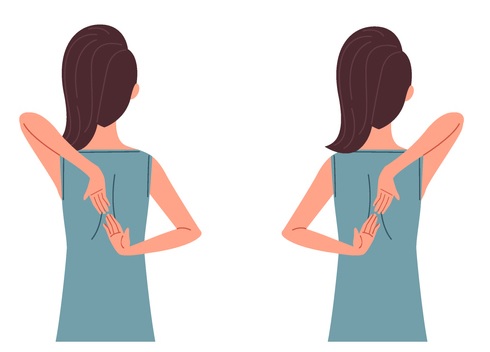
Prevention of cervical spine muscle pain
The functionality and physiology of the musculoskeletal system depends on the condition and balance of individual muscles and muscle groups.
In sedentary employment, compensation by regular physical activity is necessary. In manual or unilateral load-bearing employment, compensatory physical activity of the inactive muscle groups is appropriate.
Adequate regeneration of muscles that are subjected to excessive activation and stimulation on a daily basis is important. In sedentary employment, this applies in particular to the back muscles due to incorrect sitting and incorrect posture and head posture.
The basis of musculoskeletal physiology and pain prevention is muscle balance - strengthening and activating weakened muscles and, conversely, relaxing overstretched or shortened muscles.
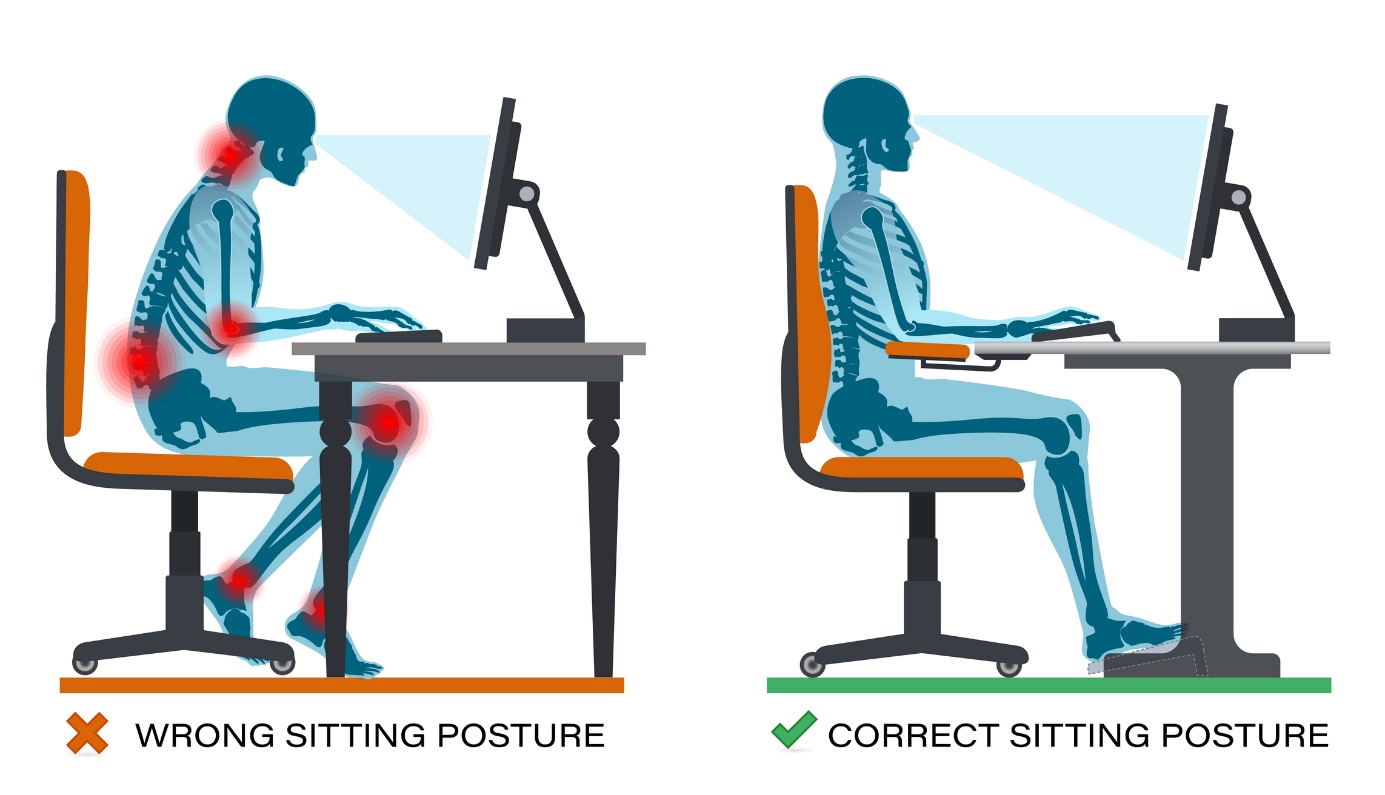
Release of muscle tension
The above kinesiotherapy (movement therapy) forms the basis for the prevention of muscle imbalances. In addition, the following tips and advice can be used to release overstretched muscles.
Tips for relaxing muscles:
- Adequate intake of magnesium
- Adequate intake of potassium
- Stretching the muscles (stretching)
- Application of heat (for non-inflammatory process)
- Regenerative herbal bath
- Rest regime
- Application of topical gels and ointments
- Massage
- Relaxation kinesiotaping
- Visit of a physiotherapist
- Daily ergonomics
- Correction of sitting at work
It is advisable to use specialised exercises under the guidance of a therapist. Once you have mastered them, you can practice them in the comfort of your own home.
Tips on physiotherapy methods for back exercises: the McKenzie method, the SM-system (spiral stabilisation system), Klappa climbing or the DNS method (dynamic neuromuscular stabilisation).
Interesting information in the article:
What is effective help for back or cervical spine pain
Interesting resources










